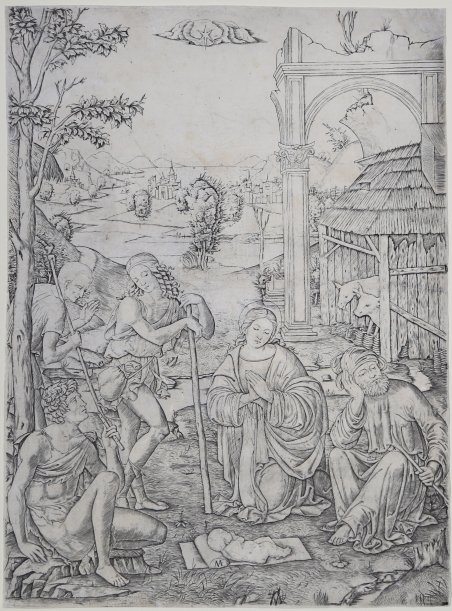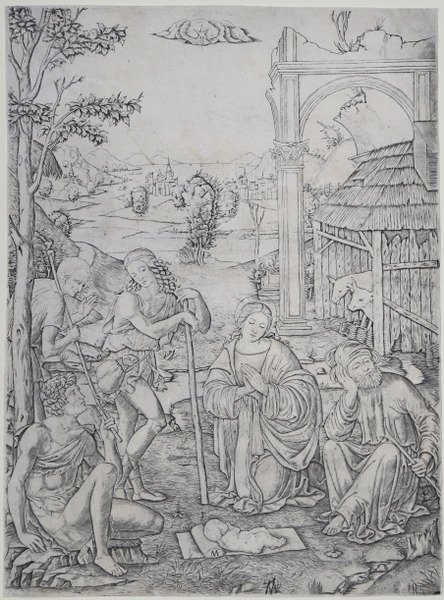Bulino, datato e monogrammato in lastra, in alto a sinistra: “1516/A. V.”Bulino, 1504 circa, firmato in lastra con il monogramma "MAF" all'estremità del cuscino su cui poggia Gesù Bambino. Primo stato, di due, secondo Delaborde, avanti l’aggiunta delle aureole sulle teste della Sacra Famiglia.Bell’esemplare, impresso su carta vergata coeva con filigrana “testa di giullare”, rifilato alla linea marginale, restauro all’angolo superiore destro, nel complesso molto buono lo stato di conservazione.Bartsch, Passavant e Delaborde concordano nell’ipotizzare un disegno preparatorio del Francia, mentre Jebens individua la fonte nell’Adorazione del Bambino realizzata nel 1499 del Francia (Pinacoteca Nazionale, Bologna). Shoemaker vi vede piuttosto un’opera composita costituita dall’assemblaggio di motivi diversi: oltre all’Adorazione, il pastore appoggiato al bastone richiamerebbe l’analoga figura nella “Natività” del Francia (Pinacoteca Nazionale, Bologna). È indubbio, però, che Marcantonio inserisca anche suoi disegni autografi, come ha sottolineato Oberhuber. L’influenza della cultura nordica, e in particolare del Dürer sul paesaggio, è ormai unanimemente riconosciuta. Circa la datazione, secondo Folds e Shoemaker la mancanza di effetti volumetrici convincenti, dovuti a linee di bulino piuttosto corte e non arrotondate, fa propendere per un’esecuzione anteriore a “Piramo e Tisbe”: 1504 per Shoemacker, 1504 o 1505 per Folds. Delaborde individuò due stati della lastra, il primo caratterizzato dall’assenza dell’aureola sulle teste della Sacra Famiglia.L’Adorazione dei Pastori costituì il modello per diverse maioliche cinquecentesche di ambito faentino. //// Engraving, 1504 circa, signed with monogram 'MAF' on the end of the pillow Christ rests on. First state.Good example, printed on contemporary laid paper, with “foolscap” watermark, trimmed close to platemark, a restoration in the upper right corner, otherwise in good condition.Shoemacker, The engravings of Marcantonio Raimondi, p. 52, n. 1: “[…]The “Adoration of Shepherds”, acknowleged to be one of the Marcantonio’s earliest engravings, includes several motifs borrowed from Francia’s “Adoration of Shepherds” altarpiece of 1499 (Bologna, Pinacoteca); he took over the figure of the Virgin, the central tree, and the broken arch in the background. The mannered gesture of the shepherd leaning on his staff may also be borrowed from a figure in Francia's Nativity (Bologna, Pinacoteca). Folds has suggested that the shepherd crouched in the lefthand corner of the engraving was based upon an ancient model, noting also that the figure displays an early attempt on Marcantonio's part to render the sculptural qualities of an ancient nude. Although no sources are known for the other figures, the additive character of the composition makes it easy to imagine that Marcantonio created it piecemeal by combining figures from paintings and drawings that came from Francia's workshop. The figures fill the width of the foreground plane, and the background opens into a vast distance that is connected with the foreground in only rudimentary fashion. One senses again the piecemeal approach of the artist, who seems to have borrowed the central group of trees and distant towers from the background of one of Dürer's prints. Marcantonio clearly had trouble integrating the landscape with the ruined arch in the middleground. The hills and tree seen through the arch seem much nearer than the generalized mountains to the left of the pilasters. In an effort to fill an empty space Marcantonio even tilted the small fir tree beneath the arch.Marcantonio’s engraving technique is fairly delicate in the “Adoration of the Shepherds”, and there are few strong contrasts of light and dark. He outlined the forms with fine contour lines and used closely-spaced parallel strokes for shading. The shading technique flattens the forms because the lines are straight rather than curving. Yet the rounded areas of light on the arms and legs of the figures, which Marcantonio created by limiting the lengths of the shading lines, indicate that he intended to suggest volume. To do this, Marcantonio disciplined and simplified his technique, a method that in slightly later prints like the “Pyramus and Thisbe” is more effective because of his more accom- plished figure style.” Bartsch, XIV, 17, 16; Passavant VI, 12, 8; Shoemaker , 1981, p. 52 n. 1; Bologna e l’Umanesimo, p. 110 n. II; Delaborde, 7.


Descubre cómo utilizar
Descubre cómo utilizar

